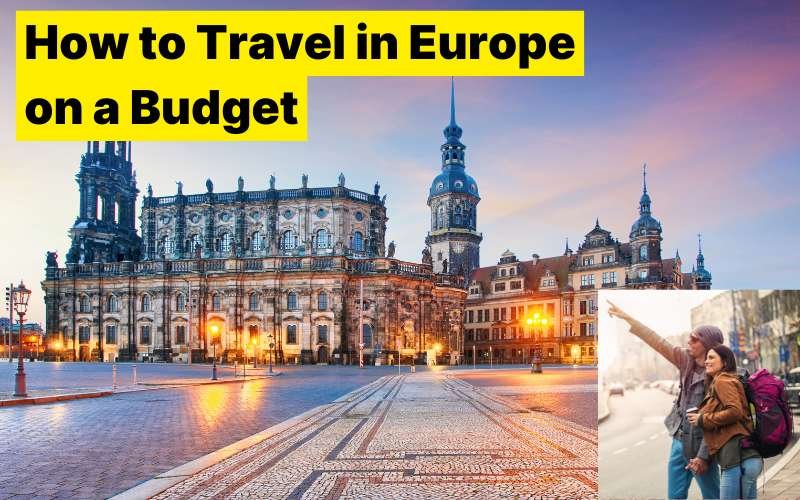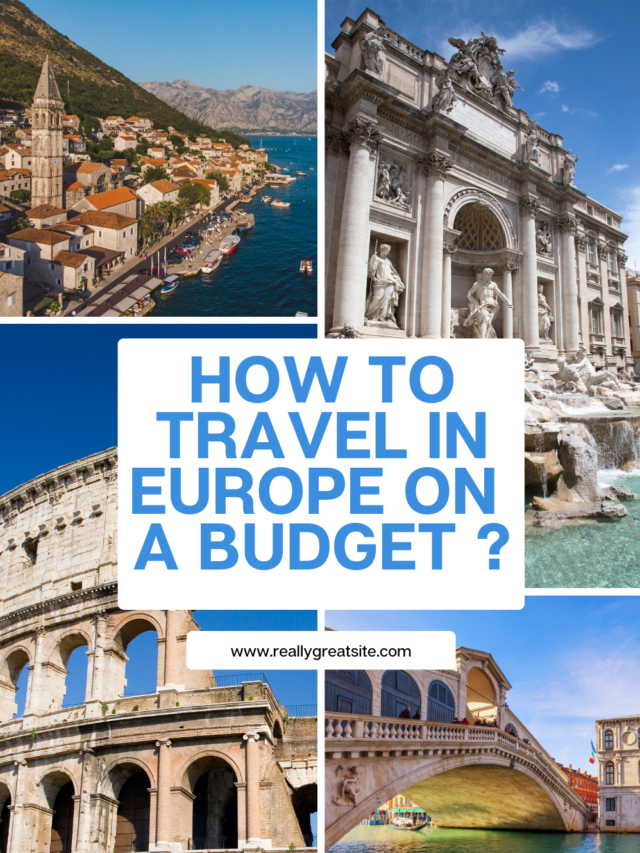Traveling through Europe is a dream for many. The continent is rich with history, culture, and stunning landscapes, but the costs can add up quickly. The good news? With the right strategies, you can explore Europe without breaking the bank.
In this guide, we’ll dive into how to travel Europe on a budget while still making the most of your trip.
Best Way to Travel Europe on a Budget

Setting a realistic budget is the first step in planning a budget-friendly trip to Europe. Europe offers a wide range of experiences, from luxurious to extremely affordable, so it’s essential to know how much you’re willing and able to spend.
Key-Points
- Travel in off-peak seasons.
- Use Budget airlines like Ryanair or Wizz Air.
- Book accommodations through budget-friendly platforms like Hostelworld.
- Take advantage of free walking tours in major cities.
- Save on food by eating like a local.
Expert Tips for Budget Travel in Europe
1. Set a Realistic Budget
Before you start booking flights and accommodations, sit down and calculate your overall budget.
Consider how long you’ll be traveling and factor in the costs of flights, accommodations, transportation, food, and activities. It’s crucial to plan with a buffer for unexpected expenses.
For example, if you’re planning a month-long trip, your daily budget might range from $50 to $150, depending on the countries you plan to visit and your travel style.
Countries in Eastern Europe, like Poland, Hungary, and Romania, tend to be more affordable, while Western European countries, like France and Germany, can be pricier.
2. Choose Budget-Friendly Destinations
Europe is diverse, and the cost of traveling can vary greatly between countries. Eastern Europe is a goldmine for budget travelers.
Countries like Bulgaria, Serbia, and the Czech Republic offer stunning scenery, rich history, and vibrant culture at a fraction of the cost of more popular destinations like Paris or London.
- Poland: With beautiful cities like Kraków and Warsaw, Poland is affordable and full of history.
- Hungary: Budapest offers thermal baths, stunning architecture, and affordable prices.
- Portugal: Lisbon and Porto are charming cities with budget-friendly prices and delicious food.
Traveling to less touristy areas or choosing destinations like Greece or Portugal during off-peak seasons can also save you money.
Read More: Best Places to Visit in Europe
3. Travel during Off-Peak Seasons

One of the best ways to save money when traveling in Europe is to visit during the off-peak season.
This usually means traveling in late fall, winter, or early spring. During these times, airfares and accommodations are cheaper, and tourist spots are less crowded.
There are four main seasons in Europe:
- Spring from April to May.
- Summers from June to mid-September,
- Fall/Autumn from mid-September to mid-November.
- Winters from mid-November to March.
For example, visiting Italy in October or November (Fall Season) instead of during the summer can save you money and provide a more relaxed experience. Flights and hotels are significantly cheaper, and you’ll have a better chance of interacting with locals than other tourists.
4. Choose Affordable Transportation Options
Getting around Europe doesn’t have to be expensive. You can navigate the continent without spending a fortune with various budget-friendly transportation options.
i. Travel in Low-Cost Budget Airlines


Europe is home to several low-cost airlines that make it easy to hop between countries without blowing your budget. Ryanair, EasyJet, and Wizz Air are among the most popular, offering cheap flights across the continent.
When booking flights, booking early and being flexible with your dates is essential.
Low-cost airlines often have sales where you can find flights for as little as $20 (Unbelievable!). However, keep in mind that these airlines charge extra for checked baggage, seat selection, and even printing your boarding pass at the airport.
Note: Pack light and read the fine print to avoid extra fees.
ii. Use Train to Travel on a Budget
Traveling by train is one of the most scenic and relaxing ways to see Europe, and it doesn’t have to be expensive.
Rail passes like the Eurail Pass or Interrail Pass offer great value if you visit multiple countries. These passes allow for unlimited travel within a certain number of days, making them ideal for those who want the flexibility to move around.
If you’re only visiting one or two countries, booking tickets in advance can lead to significant savings.
Websites like Trainline and Omio allow you to compare prices and routes across different train operators.
Another tip is to consider overnight trains. Not only will you save on accommodation, but you’ll also wake up in a new city, ready to explore.
iii. Use Bus and Carpooling Options
For the ultimate budget-friendly travel, consider buses and carpooling. FlixBus and Eurolines are two major bus companies that offer cheap fares across Europe. While the journey might be longer than by train or plane, the cost savings can be significant.
Carpooling services like BlaBlaCar are also popular in Europe. This platform connects drivers with passengers heading in the same direction, splitting the cost of the journey. It’s a great way to meet locals and see the countryside while saving money.
5. Stay in Budget-Friendly Accommodation
Finding affordable places to stay is crucial to traveling to Europe on a budget. Fortunately, there are plenty of options that don’t involve sacrificing comfort.
i. Stay in Hostels or Budget Hotels
Hostels are the go-to choice for budget travelers in Europe. Not only are they inexpensive, but they also offer opportunities to meet other travelers. Many hostels provide private rooms if you’re looking for a bit more privacy, and some even include breakfast in the price.
Budget hotels are another option, especially in less touristy areas. Websites like Booking.com and Hostelworld make comparing prices easy and allow you to read reviews from other travelers.
When booking accommodations, consider staying outside the city center. Public transportation in Europe is generally excellent, so waiting a bit further out can save you money without being inconvenient.
ii. Alternative Accommodation Options
If you’re looking for something different from the typical hotel or hostel, consider Airbnb, Couchsurfing, or house-sitting.
- Airbnb: Renting a room or an entire apartment on Airbnb can be more cost-effective than a hotel, especially if you’re traveling with a group. Plus, having access to a kitchen allows you to save money by cooking your meals.
- Couchsurfing: This platform connects travelers with locals who offer free places to stay. It’s a fantastic way to meet people and experience a city from a local perspective.
- House-sitting: Websites like TrustedHousesitters offer opportunities to stay in someone’s home for free while caring for their pets or property. It’s a win-win for both parties.
iii. Booking Tips
When it comes to booking accommodations, timing is everything. Booking in advance often secures the best rates, but last-minute deals can also be found if you’re flexible.
Use comparison websites like Trivago or Kayak to find the best deals. If you plan on staying in the same chain multiple times during your trip, consider using hotel loyalty programs.
6. Save on Food and Drinks by eating like a Local
Food can be one of the biggest expenses when traveling, but with a few smart choices, you can eat well without overspending.
i. Eating Like a Local
Eating like a local is not only cheaper but also more authentic.
Avoid touristy restaurants, which are often overpriced, and seek out local markets, street food stalls, and neighborhood eateries. Not only will you save money, but you’ll also get to taste the real flavors of the region.
Local markets in cities like Barcelona or Athens are great places to grab fresh produce, cheeses, and bread for a picnic. Street food, like kebabs in Turkey or crepes in France, can be filling and affordable.
ii. Cooking Your Meals
If you’re staying in a hostel, Airbnb, or any accommodation with a kitchen, consider cooking some of your meals. Shopping at local grocery stores and preparing your food can save significant money, especially in expensive cities.
For example, in Switzerland, where eating out can be particularly pricey, cooking your meals can help keep your budget in check. Simple dishes like pasta, salads, and sandwiches are easy to prepare and can be made with local ingredients.
iii. Affordable Dining Strategies
If cooking isn’t an option, there are still ways to dine out without overspending. Look for lunch specials, set menus, or happy hour deals. In many European countries, lunch is the main meal of the day, and restaurants often offer a set menu (prix fixe) that includes multiple courses at a reduced price.
Another tip is to avoid restaurants in tourist hotspots. Walking a few blocks away from major attractions can lead you to more affordable and authentic dining options.
7. Opt for Budget-Friendly Activities and Sightseeing
Europe is full of incredible sights, many of which can be enjoyed on a budget—or even for free.
i. Free and Low-Cost Attractions
Many European cities offer free walking tours, which are a great way to learn about the city’s history and culture. While the tours are free, it’s customary to tip the guide if you enjoyed the experience.
Museums and galleries often have free entry days or reduced prices at certain times. For example, the Louvre in Paris is free on the first Saturday of each month, and many museums in London are always free.
Parks, gardens, and outdoor spaces are also fantastic (and free) ways to enjoy Europe’s beauty. Picnicking in Hyde Park in London or exploring the gardens at Schönbrunn Palace in Vienna are wonderful experiences that won’t cost a dime.
ii. Discount Cards and Passes
Many cities offer discount cards or passes that provide free or reduced entry to attractions and unlimited use of public transportation. The Paris Pass, Rome Pass, and Barcelona Card are just a few examples.
These passes can be a great deal if you plan to visit multiple attractions in a short period. However, make sure to calculate whether the pass will save you money based on your itinerary. Sometimes, paying per attraction might be cheaper if you’re only visiting a few places.
iii. Travel Hacks for Sightseeing
When it comes to sightseeing, doing a bit of research ahead of time can save you both time and money. Booking tickets online in advance often comes with a discount and allows you to skip the lines.
Another hack is to explore by foot or bike. Many European cities are very walkable, and renting a bike is often inexpensive. Not only will you save on transportation costs, but you’ll also get to see more of the city at your own pace.
Additional Budget Travel Tips
Finally, here are some additional tips on how to save money while traveling in Europe and make the most of your budget European adventure.
i. Useful Apps to Save Money
Technology can be your best friend when traveling on a budget. Numerous apps are designed to help you save money on the go.
- Skyscanner: Great for finding cheap flights.
- Rome2rio: Helps you figure out the best transportation options between two points.
- XE Currency: Keeps you updated on currency exchange rates.
- Splitwise: Perfect for keeping track of shared expenses if you’re traveling with others.
These apps can help you find deals, plan your trip, and avoid unnecessary expenses.
ii. Managing Money and Avoiding Fees
When traveling internationally, managing your money wisely is crucial. Look for credit cards that don’t charge foreign transaction fees, and consider opening an account with a bank that offers free ATM withdrawals abroad.
Avoid exchanging currency at airports or in tourist areas, where rates are often unfavorable. Instead, withdraw local currency from ATMs, which offer better exchange rates. Just be sure to use ATMs associated with reputable banks to avoid excessive fees.
iii. Staying Safe on a Budget
Safety should always be a priority, even when traveling on a budget. Opt for secure accommodations with good reviews, and keep your belongings safe by using lockers or safes.
Travel insurance is another area where you shouldn’t skimp. While it might seem unnecessary, travel insurance can save you from significant costs if something goes wrong. It covers everything from medical emergencies to trip cancellations, giving you peace of mind as you explore Europe.
Conclusion – Cheap ways to travel Europe
Traveling through Europe on a budget is entirely possible with the right planning and strategies. By being smart about your spending, choosing budget-friendly destinations, and taking advantage of affordable transportation and accommodations, you can have an incredible European adventure without breaking the bank.
Remember, the key to budget travel is flexibility and a willingness to embrace new experiences. Whether you’re savoring street food in Lisbon, exploring the medieval streets of Prague, or hiking in the Swiss Alps, Europe has something for every traveler—and every budget.
By following these tips and strategies in this guide, you’ll be well on your way to mastering how to travel Europe on a budget.
So, what are you waiting for? Start planning your budget European adventure today and discover how far your money can take you!
Happy travels!



